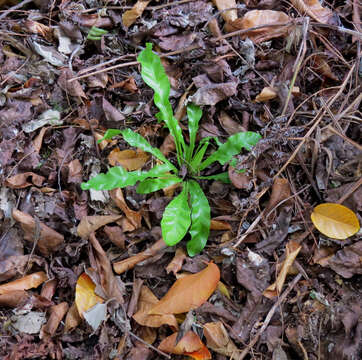Asplenium nidus

Description:
kaha, kaha kuahiwi or Bird's nest fernAspleniaceae (Spleenwort family)Indigenous to the Hawaiian Islands (all islands except Niihau & Kooholawe)Oahu (Cultivated; Oahu origin)Newly planted young kaha, barely 10 inches from tip to tip, is provided space to grow to full potential in the rich soil of my fern garden. These magnificent naturally ferns grow as terrestrial, lithophytes or epiphytes.New kaha growing as an epiphytewww.flickr.com/photos/dweickhoff/47397051222/in/photolist...Mature kahawww.flickr.com/photos/dweickhoff/12073042346/in/photolist...Hawaiian Namekaha kuahiwi means "mountain kaha."The dark midribs of kaha fronds were woven by early Hawaiians into lau hala mats and other objects of lau hala to provide pattern and color contrast.The ferns were ceremonially planted to cover residual stumps after a tree had been felled for canoe (waa) making.Medicinally, a liquid made from kaha leaf shoots and mixed with other plants was used to treat children and infants with ea or thrush and paoao, a disease which physically weakens. Shoots with other plants were pounded and liquid squeezed into mouths of children with mouth sores or general weakness. An ointment was also made from the leaves and mixed with other ingredients and liquid was used for ulcers or body sores (ph kolokolo kokoole). EtymologyThe genus name Asplenium is from the Latin asplenum, spleenwort. Ancient Greeks believed that this fern could cure spleen diseases.The Latin specific epithet nidus, nest, in reference to the nest-like appearance of this fern. Interestingly, besides being terrestrial, as shown in the above photo, this fern is found as an epiphyte, perhaps giving the impression of a bird's nest among the branches.nativeplants.hawaii.edu/plant/view/Asplenium_nidus
Included On The Following Pages:
- Life (creatures)
- Cellular (cellular organisms)
- Eukaryota (eukaryotes)
- Archaeplastida (plants)
- Chloroplastida (green plants)
- Streptophyta
- Embryophytes
- Tracheophyta (ferns)
- Polypodiopsida
- Polypodiales
- Aspleniaceae (spleenworts)
- Asplenium (spleenwort)
- Asplenium nidus (Hawai'I birdnest fern)
This image is not featured in any collections.
Source Information
- license
- cc-by-nc-sa
- copyright
- David Eickhoff
- photographer
- David Eickhoff
- original
- original media file
- visit source
- partner site
- Flickr Group
- ID


